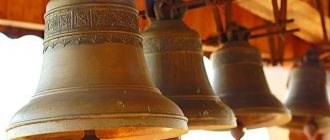A bell is a dome-shaped percussion instrument with a tongue inside. The sound from the bell comes when the tongue hits the walls of the instrument. There are also bells that do not have a tongue; they are struck from above with a special hammer or block. The material from which the instrument is made is mainly bronze, but in our time bells are often made from glass, silver and even cast iron.
The bell is an ancient musical instrument. The first bell appeared in China in the 23rd century BC. It was very small in size and riveted from iron. A little later, in China they decided to create an instrument that would contain several dozen bells of different sizes and diameters. This instrument was distinguished by its multifaceted sound and color.
In Europe, a bell-like instrument appeared several thousand years later than in China, and was called a carillon. People who lived in those days considered this instrument a symbol of paganism. Largely thanks to the legend about one ancient bell located in Germany, which was called “Pig Prey”. According to legend, a herd of pigs found this bell in a giant pile of dirt. People put it in order and hung it on the bell tower, but the bell began to exhibit a certain “pagan essence” and did not make any sounds until it was consecrated by local priests. Centuries passed and in the Orthodox churches of Europe, bells became a symbol of faith, famous quotes from the Holy Scriptures were engraved on them.
Story
A bell is a percussion musical instrument consisting of a hollow area, which is the source of sound, and a tongue suspended from it, which strikes the dome.
In Russia, bells appeared in the 10th century along with the adoption of Christianity. They performed various functions: they marked the time, called for a meeting, called for services in the church, used them to sound the alarm, and notified about a fire. Large bells in Rus' began to be made later in the 14th-15th centuries, with the advent of metallurgical plants. Foundry workers in those days created many amazing large similar instruments.
After 1917, Russian bells were cast at private factories, and in 1930 this industry was stopped altogether. And in the 90s, when this ancient art was resumed, a lot had to be learned anew.
“Hearing the gospel, I speak with You, Creator.”Zhukovsky V.
The production and use of bells dates back to ancient times. Bells were known to the Jews, Egyptians, and Romans.[1] Bells were known in Japan and China.
Every bell consists of three main parts: 1) mounting ear, 2) bell head (frame), 3) fields, 4) tongue.
In ancient times, bells were small and were not cast from metal as they are now, but riveted from sheet iron.[2] Later, bells began to be riveted from sheet copper and bronze.
It is not known exactly when bells began to be used in Christian worship. During the persecution of Christians, the use of bells was out of the question; the call to worship was carried out through special persons of the lower clergy (Laosinacts-collectors of the people).
Church tradition dates the first use of bells in Christian worship to St. Paulinus, Bishop of Nolan (353-431). In a dream vision, he saw an angel with bells that made wonderful sounds. Wildflowers and bluebells suggested to St. The peacock is in the shape of bells, which were used during the service.
Historical monuments of the West first mention bells only in the 7th century, at churches in Rome and Orleans.[3] By the 8th century. in the West, thanks to Charlemagne, church bells were already widespread. Bells were made from an alloy of copper and tin; later, iron and, in rare cases, silver were added to these metals.[4]
The middle of the 9th century can be defined as the time of widespread use of bells in the Christian West.
In the Orthodox East, bells appeared only in the second half of the 9th century, when, at the request of Emperor Basil the Macedonian (867-886), the Venetian Doge Orso sent 12 bells to Constantinople for the newly built church. This innovation was not widespread, and only after the occupation of Constantinople by the crusaders (1204) did bells begin to appear at churches again.
The appearance of bells in Rus' dates back to the very origins of Christianity. It is historically justified that bells came not from Byzantium, but from the West, [5] but their widespread use dates back to much later times. It took considerable time for the “new bells” to organically enter church life.[6]
The first chronicle mention of bells in Rus' dates back to 988. In Kyiv there were bells at the Assumption (Tithe) and Irininskaya churches. In Novgorod, bells are mentioned at the church of St. Sofia at the very beginning of the 11th century.[7] In 1106, St. Anthony the Roman, arriving in Novgorod, heard a “great ringing” in it. Bells are also mentioned in the churches of Polotsk, Novgorod-Seversky and Vladimir on Klyazma at the end of the 12th century.
During excavations of the foundations of the Church of the Tithes (1824), which was headed by Metropolitan Evgeniy (Bolkhovitnikov) of Kiev, two bells were discovered. One of them is made of Corinthian copper, better preserved (weighing 2 pounds 10 pounds, [8] 9 inches high), it is considered the oldest Russian bell.
Russian bell-making masters were first mentioned in a chronicle in 1194. In Suzdal, “and that miracle was like the prayer and faith of Bishop John, not the claimant of the craftsmen from the Germans, but the presence of the craftsmen from the minions of St. Mother of God and their own, others pour tin...” At the beginning of the 12th century. Russian craftsmen had their own foundries in Kyiv. The oldest Russian bells sounded small, completely smooth and had no inscriptions.
After the invasion of the Tatar-Mongols (1240), bell making in Ancient Rus' died out.
In the XIV century. Foundry is being resumed in North-Eastern Rus'. Moscow becomes the center of foundry business. “The Russian Boris” gained particular fame at this time, casting many bells for cathedral churches.[9] The size of the bells at that time was small and their weight did not exceed several pounds.
A remarkable event in 1530 was the casting of a bell by order of the Novgorod Archbishop St. Macarius weighing 250 pounds. Bells of this size were very rare, and the chronicler notes this event of great importance, “this has never happened before.” At this time, inscriptions on bells were already found in Slavic, Latin, Dutch, and Old German. Sometimes the inscriptions could only be read using a special “key”. At the same time, a special rite of consecration of bells appeared.
Rostov ringings occupy a special place among all Russian bells. The largest “Sysoy”[23] weighing 2000 pounds was cast in 1689, “Polieleyny” 1000 pounds in 1683, “Swan” weighing 500 pounds was cast in 1682. There are 13 bells in the belfry of the Rostov Kremlin.[24] In Rostov they ring from notes specially composed for three tunes: Ioninsky, Akimovsky and Dashkovsky, or Egoryevsky.
In 1907, the bells of the Church of the Resurrection of Christ (on Blood) in St. Petersburg rang for the first time. Four large and many small bells, for the first time this year, called pilgrims to the first prayer service. The famous Rostov archpriest Aristarkh Izrailev tuned the bells. Father Aristarchus “taught” the bells to play, in addition to liturgical ringings, “God Save the Tsar,” “Kol Slaven” and other melodies. By the beginning of the 20th century, the St. Petersburg ringings were superior in tonal diversity and melody to the Moscow and even Rostov “raspberry ringings”. Careful selection of bells according to their sound provided the St. Petersburg bells with exceptional musicality.
Mostly all bells were made of special bell copper. But there were bells made of other metals. There were cast iron bells in the Dositheeva Hermitage on the banks of the Sheksna. The Solovetsky Monastery had two stone bells. In the Obnorsky monastery there were 8 bells made of sheet iron. There was a glass bell in Totma. In Kharkov, in the Assumption Cathedral there was a bell weighing 17 pounds made of pure silver.[25] There were six gilded bells in Siberia in the city of Tara, at the Kazan Church. They are all small, from 1 to 45 poods.
Bells weighing over 1,000 pounds were found in many churches and monasteries and were commonplace.
By 1917, there were 20 large bell factories in Russia, which cast 100-120 thousand pounds of church bells per year.[26]
Bells, having traveled a long historical path, have become an integral part of the life of the Russian people for Russia. Without them, not a single Orthodox church was unthinkable; all events in the life of the state and the Church were consecrated by the ringing of bells.[27]
After the October Revolution of 1917, church bells became especially hated by the new government. The ringing of bells was considered harmful, and by the early 1930s all church bells fell silent. According to Soviet law, all church buildings, as well as bells, were placed at the disposal of Local Councils, which “based on state and public needs, used them at their discretion.” It was then that instructions from the People's Commissar of Finance units “On the procedure for liquidating church property” appeared. Secret instructions allowed the destruction of part of the religious property. Church property turned into a significant source of income (40% of the proceeds went to the local budget), which in turn encouraged the strengthening of atheistic policies, the closure and demolition of churches. Most of the church bells were destroyed. A small part of the bells of artistic value was registered with the People's Commissariat for Education, which disposed of them independently “based on state needs.”
To liquidate the most valuable bells, a decision was made to sell them abroad. “The most expedient way out for eliminating our unique bells is to export them abroad and sell them there along with other luxury items...” wrote the ideologist of atheism Gidulyanov. Thus, in the USA, at Harvard University, the unique bells of the Danilov Monastery turned out to be.[28] The unique bells of the Sretensky Monastery were sold to England. A huge number of bells went into private collections. Another part of the confiscated bells was sent to large construction sites in Volkhovstroy and Dneprostroy for technical needs (making boilers for canteens!). Russia was losing its bell wealth catastrophically quickly. The seizure of bells from ancient monasteries and cities was especially noticeable. In 1929, the 1200-pound bell was removed from the Kostroma Assumption Cathedral. In 1931, many bells of the Savior-Evfimiev, Rizopolozhensky, and Pokrovsky monasteries in Suzdal were sent for remelting.
Even more tragic was the story of the death of the famous bells of the Trinity-Sergius Lavra. The death of the pride of Russia - the bells of the first monastery in Rus' - was followed by many. Illustrated official publications such as “Atheist” and others printed photographs of the overthrown bells. As a result, 19 bells with a total weight of 8165 pounds were handed over to Rudmetalltorg from the Trinity-Sergius Lavra. In his diary about the events in the Trinity-Sergius Lavra, the writer M. Prishvin wrote: “I witnessed the death ... the most majestic bells in the world of the Godunov era were thrown down - it was like the spectacle of a public execution.”
Parts of Moscow bells were found in a unique way in 1932 by the capital’s authorities. Bronze high reliefs were cast from 100 tons of church bells for the new building of the Lenin Library.
In 1933, at a secret meeting of the All-Russian Central Executive Committee, a plan was established for the procurement of bell bronze. Each republic and region received a quarterly allocation for the procurement of bell bronze. Over the course of several years, in a planned manner, almost everything that Orthodox Rus' had carefully collected for several centuries was destroyed.
| Photo: www.xxc.ru |
Currently, the art of casting church bells is gradually being revived.
With the blessing of His Holiness Patriarch Alexei II of Moscow and All Rus', the Bells of Russia Foundation was established, which revives the ancient traditions of bell art. In their workshops, bells from 5 kg to 5 tons are cast. The largest bell in recent years was the bell for the Cathedral of Christ the Savior in Moscow. Bibliography
- Belov A. When the bells ring. - M., 1988.
- Gidulyanov P.V. Church bells in the service of magic and tsarism. - M.: Publishing house "Atheist", 1930.
- A clergyman's handbook. - M., t.4, 1983.
- Olovyanishnikov N. History of bells and bell art. - M., 1912.
[1]The Jews used small bells to decorate the clothes of the high priest (Ex. 28, 33-35) and (2 Chron. 4, 13.).
The Greeks used small bells at the temple of Cybele and Prozernina, with which they called for worship. The oldest known is the Assyrian bell from the time of Shalmaneser 2 (860-824 BC), from the palace of Ninivea and kept in the British Museum. [2] An example is the bell of 613. from the church of St. Sidilia, now in the Cologne Museum. [3]Under Pope Sabinianus (604-606). [4] Pope John XIV established the custom of “baptizing” bells, in which each of them was given the name of a saint. [5] The word bell itself comes from a German word, but there is an opinion that this word comes from the old Russian word kolo-krug. [6] In Rus', as in Byzantium, beats and rivets were used to call to worship. There are still mentions of them in the Typikon (chapter 7, after Easter). Beats were especially widespread in Rostov and were used until very late times along with bell ringing. Even in the Gethsemane monastery of the Trinity-Sergius Lavra, founded in 1844, a large wooden beater was in use. [7]In 1066, the Polotsk prince Veslav removed the bells from the St. Sophia bell tower. [8]One pood is 16 kg, one pound is 200 gr. [9] In the chronicle of 1342 the following is narrated: “Vladyka Vasily commanded to cast a great bell to St. Sophia and bring a master from Moscow, a good man, named Boris.” [10]Part of it has been preserved in Moscow, somewhat in the Trinity-Sergius Lavra. [11]Peter Petrey de Erlesund History of the Grand Duchy of Moscow M., 1867, p. 5-6. [12]This bell was cast for the bell tower of Ivan the Great. In 1812, after Napoleonic troops attempted to blow up the bell tower, the bell fell, as a result of which its “ears” broke off. After the liberation of Moscow it was repaired. Another event is connected with this bell. During the oath of allegiance to Alexander II in the Kremlin (Lent 1855), this bell fell and crushed 10 people. During the coronation of Alexander II, it fell a second time, breaking through three arches and crushing 17 people. Then St. Filaret (Drozdov) said: “The reign will be good, but the end will be unfortunate.” The bell was repaired, but became unusable in 1912. [13] Bell copper is much softer than the copper needed to make military tools. [14]Perhaps the Novgorod “Veche” bell was re-cast. [15] 1,214,000 units were used for the construction of furnaces. bricks [16] There is an opinion that the bell was nevertheless raised from the foundry pit, but this is not documented. [17] In 1833, Emperor Nicholas I entrusted the famous architect and engineer Montferand with the work of raising the Tsar Bell. On the second attempt the bell was raised (in 43 minutes). [18] Metal composition: copper - 84.5, tin - 13.2, sulfur - 1.2, gold - 0.036 (about 72 kg), silver - 0.25 (about 525 kg), loss - 1.03 (in loss includes the remainder of zinc and arsenic). A study of the copper composition of other famous bells in Russia did not give positive results for the content of gold and silver. [19]Nowadays it is the largest operating bell in Russia. The best in tone and sound. The largest bell in use in the world, cast in 1632, weighing 4,685 pounds, is located in Japan in the city of Kyoto. [20]Back in the 19th century. gave a crack. [21]The bell miraculously survived the closure of the monastery. [22] On the bell is the inscription: “Broadcast great joy to the earth, praise the heavens of God’s glory; Glory to Thee, our God, glory to Thee” [23] Received its name in memory of the Rostov Metropolitan Jonah (Sysoevich). [24]For many years in the 19th century. The harmonic tuning of the Rostov bells was carried out by Archpriest Aristarkh Izrailev. [25]The bell was cast under Nicholas II in 1890 at P. Ryzhov’s factory. in memory of the deliverance from the death of the royal family in a train crash. Disappeared without a trace during the civil war. [26] The most famous were: in Moscow the Bogdanov plant, in Yaroslavl the Olovyanishnikov and Zatropezny plants. [27]The second place in the wealth of bells belonged to England at that time. [28]Sold by the Soviet government in the 30s of the 20th century. Starodubtsev Oleg Viktorovich
16/10/2001 Related links:
Revival of bell ringing in Russia Bells and Orthodox ringing (Association of Bell Art of Russia)
Veche Novgorod bell
Have you heard that the history of this item is full of many legends? In 1478, Ivan 3 annexed Novgorod to the Principality of Moscow, and the Novgorod bell was removed from the bell tower and transported to Moscow, where it was placed in the belfry of the Assumption Cathedral. Then it was poured into the alarm, which was located in a small half-tower next to the Spassky Gate.
And in 1861, due to the fact that he frightened Fyodor Alekseevich, he was exiled to the Nikolo-Karelian Monastery. The people did not want to accept the fate of the bell and composed many tales about it. The most famous legend is that he did not want to be in Moscow.
And during its transportation, it crashed on the Valdai steeps and thereby became the parent of the Valdai bells, which roam along Russian roads and sing songs that they will soon return to Novgorod, which will revive its former glory.
Bell ringing: myths and superstitions
The ringing of bells creates a special atmosphere in the temple, helping believers tune into a special state of prayer. However, many people attach some mystical significance to the ringing. You can often hear that the sound of a bell kills the influenza virus. However, as practice shows, bell ringers, along with other parishioners, also suffer from colds. Therefore, the desire to use bell ringing for healing is just a superstition.
“The bell is part of the temple, and the temple as a whole serves one purpose - the salvation of the soul. Any priest will tell you that what really helps is repentance, prayer, the desire to save your soul and the understanding that the Church is, first of all, the house of God, and you need to turn to God for help. If we do not turn to Christ, but turn to the house, then we are fools, because, instead of asking for mercy from the Master of the house, we are trying to achieve something from the stones from which this house is made” (bell ringer of the Moscow Kremlin and the Cathedral of Christ Savior, biologist by training Konstantin Mishurovsky).
The Tsar Bell
Never thought that this specimen is the largest in the world. And this is undoubtedly true. It is also called a monument to Russian foundry workers. The symbol began to be created during the time of Boris Godunov. During this entire period, it was destroyed twice in fires and was restored, each time increasing its mass.
Under Anna Ioannovna, it already weighed more than 200 tons and work on its restoration was carried out right on the square. In 1737, its ceiling caught fire, as a result the bell cracked and a piece weighing 11.5 tons fell off.
Evangelists
Annunciators have a signaling function and are mainly intended to convene believers to Divine services. They can be divided into the following types:
Holiday bells . Used on the twelve holidays, the feast of Holy Easter, and at the meeting of the bishop. The abbot of the Temple can bless the use of the holiday bell on other days, for example, the consecration of the altar in the temple. The holiday bell should be the largest in weight in the set of bells.
Sunday bells. Used on Sundays and great holidays. If there is a holiday bell, the Sunday bell should be second in weight.
Lenten bells. Used as an evangelist only during Lent.
Polyeleos bells. They are used on days when the Polyeleos Divine Service is celebrated (in the Typikon they are designated with a special sign - a red cross).
Everyday (simple day) bells. Used on weekdays of the week (week).
In addition to the gospel, large bells alone (without other bells) are used when singing “Most Honest...” at Matins and “Worthy...” at the Divine Liturgy. Annunciators are also used for chimes, ringings, and trezvons. Thus, the use of one or another type of evangelist depends on the status of the service, the time of its performance or the moment of the service.
In addition, the group of evangelists can include the so-called hour bells , which “chime” the hours.
Popular message topics
- Exploring Africa
Thanks to the development of technical and information progress, today there are practically no undeveloped areas of the globe, with the exception of small islands in the ocean. In the ancient period, any discovery required a colossal - Planet Mars
Mars, or as it is called, the Red Planet, was named after the ancient Greek god of war Ares, or, in Roman mythology, Mars. This name was associated with the blood-red color of the planet, which has long been associated with war. - Space
Even ancient people wondered - what is there, high above our heads, beyond our reach? And even though these limits expanded somewhat over time, this brought more and more questions.











